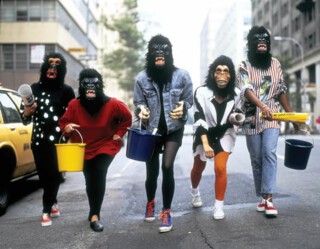To make a DIY tear-gas mask first cut the bottom off a large plastic bottle. Then turn it upside down and cut away a tall U-shaped area big enough to put your face into. Get a dust mask, soak it in vinegar and insert it into the bottle’s neck. Attach a couple of elastic bands to the edges and wear. These instructions, with accompanying diagrams, are printed on yellow paper and placed next to the exit for people to take away at Disobedient Objects, an exhibition at the V&A (until 1 February 2015) of the tools and totems of the last hundred years or so of political protest. The display of weapons, shields, flags and uniforms looks like a feral Imperial War Museum, an alternative military history written in rag and bone. On the wall at one end of the Porter Gallery a huge projection of Laurie Penny’s face announces that the only way to change things is by posing ‘a threat to property or power’. Politics ist Krieg.
One advantage of going to war in uniform is that in the heat of battle you can look up and see instantly who your friends are – a visual identity helps, the curators say, to ‘cement a movement’. There are black and white photos and a video of the ‘Revolution of the Dwarves’ of June 1988, when ten thousand members of the Orange Alternative gathered in Wrocław to protest against the communist regime, wearing orange Phrygian caps and chanting: ‘We are the dwarves!’ A good outfit can have magical powers. Like the Viking berserkers, who wore bearskins into battle to gain bear-like strength, the Guerrilla Girls – who campaign against sexism in the artworld – do battle in gorilla masks. ‘You’d be surprised what comes out of your mouth when you’re wearing a gorilla mask,’ Guerrilla Girl ‘Kathe Kollwitz’ has said. Three mannequins dressed in black with leering ape faces bare their teeth beside a yellow banner: ‘Do women have to be naked to get into the Met Museum?’
The ceiling of the exhibition is a riot of pennants and heraldry. A silky mint green banner with ‘Capitalism is Crisis’ written on it in strawberry pink – a remnant of the 2009 Climate Camp at Blackheath – connects the end of capitalism to the pleasures of dessert. A marching banner designed and stitched by Ed Hall for the South Yorkshire Community branch of Unite is more strident. It’s red, like a lot of protest art, and depicts a protest – friendly faces behind yet more banners – in order to boost the ranks of those who march behind it with a ghost army of fellow travellers. One of the banners from the 2012 MayDay protests in Seattle reclaims the heraldic device of the unicorn. In the 15th century the unicorn was often depicted wearing a collar and broken chain, to show that it had freed itself from bondage; the MayDay unicorn has rainbow hair, pink nail polish on its hooves and a cop impaled on its horn. Same same but different, as they say in Thailand.
Using the enemy’s weapons against them is a common strategy, despite the curators’ endorsement in the exhibition catalogue of Audre Lorde’s assertion that ‘the master’s tools will never dismantle the master’s house.’ One of the best alchemical weapons in the show is a 15-foot-long blanket with the Nike ‘swoosh’ on it that was knitted and crocheted by the ‘post-craft’ artist Cat Mazza and an international group of hobbyists. Where Nike tries to conceal the labour that goes into its products, Mazza’s piece makes the labour plain. It also challenges Nike’s claim to own its logo – how can anyone own a tick? – and contrasts the refinement of its makers with the thuggishness of their enemy. The shields made by the so-called Book Blocs, which have the covers of famous books on them, do the same thing: a photo of a riot cop lunging at Derrida’s Spectres of Marx nicely illustrates the point.
In one cabinet there’s a collection of fake newspapers. The Wapping Post, produced by striking printworkers at News International after they were laid off by Murdoch in 1986, breaks the story of the dispute’s cost to the taxpayer: £6 million. There are a few copies of Evading Standards, which was made to publicise the March for Social Justice in April 1997. Twenty-five thousand copies were pulped, thanks to an undercover cop who infiltrated the group in charge of the paper’s distribution, but it rose again in June 1999 for the Carnival against Capital, with a picture of Bill Clinton as Darth Maul on its cover. There’s also an ersatz edition of the Sun produced by Wapping printers in 1984 in solidarity with the striking miners, with the S of Sun replaced by a swastika. Protest art is an art of exaggeration, as the awesome puppets of the Bread and Puppet Theater company reiterate. Three of them stand by the entrance to the gallery: Iraqi women with faces like giant muesli blancmanges, more like strange gods than humans.
Disobedient Objects lionises protest movements – they’re ‘at the centre of the struggles that have won many of the rights and liberties we now enjoy’ – but it also ignores swathes of them. The exhibition suggests that political disobedience is always directed from left to right. But many of the most successful protest movements of recent times have come from the right, and many of those have developed their own costumes, props and symbolism. There’s no sign of Greece’s Golden Dawn, which has a logo inspired by classical Greek art, publishes its own magazine, and whose activists lit up the streets with flares when it received 7 per cent of the vote in the Greek parliamentary elections of 2012. There’s no sign of the English Defence League, which transmuted the Stone Island and Adidas logos into symbols of resistance to multiculturalism. There’s no sign either of any radical jihadist organisations, though their ‘disobedient’ publications, videos, costumes, weapons and so on have played a large part in engineering the glamour that has seduced their recruits. ‘Activism is never a waste of time,’ one of the talking heads in the video on the wall declares – but disobedient object-making can be adapted for the restriction of freedoms as well as their defence.
There are other ways of doing politics besides raising an army. The cleverest thing at the exhibition is an app created by the Italian tech-activist group Molleindustria called Phone Story. It’s a computer game in which you have to manage the production of an iPhone: you start by forcing Congolese children to mine coltan, then you try to prevent workers at a factory in China from committing suicide; in the final level you dump tons of electronic waste in Pakistan. ‘Don’t pretend you’re not complicit,’ a robot wheedles at you. Not many people think about where their phones come from; or their food, or most of their clothes; or what the risks of fracking are and who’s paying for it; or why unelected technocrats have power over national budgets. There’s room for more games like Phone Story, which send a message without the need for incendiaries, or megaphones, or getting kettled or beaten up.
Send Letters To:
The Editor
London Review of Books,
28 Little Russell Street
London, WC1A 2HN
letters@lrb.co.uk
Please include name, address, and a telephone number.


